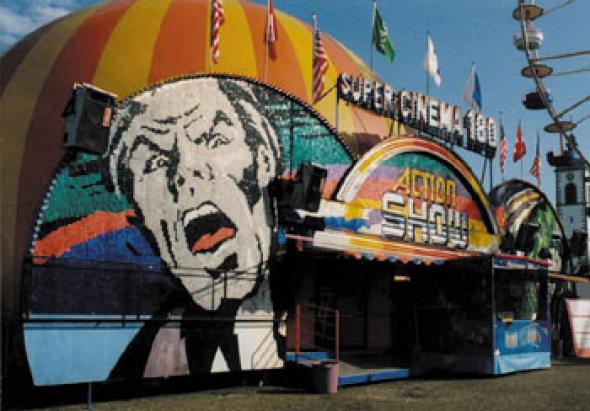180 Degrees of Separation
Mike Sperlinger loiters around at the fun fair and rediscovers the charms of some good old-fashioned spectacle – Cinema 180
Veterans of British theme parks in the early ’80s may remember Cinema 180: housed in a tent or dome, the attraction comprised a 180° curved screen onto which a 70mm film was projected. The aim was total immersion cinema, filling the field of vision – usually with awe-inspiring images of nature, or point-of-view shots from a rollercoaster. (Some screens even incorporated a drainable floor, so the auditorium could be hosed down in case of patrons’ motion sickness.)
However, the attraction has not aged well. A reviewer on the UK Theme Park Page [http://freespace.virgin.net/neil.mowforth/index.html] says of the Cinema 180 attraction at Oakwood: ‘It gives you nothing but a bad head! The screen is ripped, and the video’s haven’t been changed since it was first opened. And because your looking up at the screen your neck kills. I, like many, walked out halfway through a tedious 30 minute show.’ [Sic, sic, and sic again.] A few dilapidated screens survive, but Cinema 180, the classic wet weather attraction, was quickly superceded in most theme parks by a new generation of 3D screens and IMAX. Now the emphasis in theme parks is on more narrative, integrated forms of cinematic experience such as Back To The Future: The Ride (directed by Douglas Trumbull, special effects coordinator on Kubrick’s 2001).
Cinema 180, however, represents a different lineage. It is an enduring vestige of what Tom Gunning has called ‘the cinema of attractions’; that is, the early cinema of sheer spectacle and sensation, consistently marginalised by film historians with eyes only for the evolution of narrative. From this point of view, these crumbling theme park cinemas in fact stand in opposition to ‘theme park cinema’, the post-Spielberg cinema of effects. As Gunning puts it: ‘effects are tamed attractions.’ Cinema 180’s kitschy blend of nature doc and white-knuckle footage, blissfully incoherent and technologically inadequate (scratched old prints projected through a giant fish-eye lens), put it closer to the Lumières than the film/ride hybrids.
Just as Cinema 180 is on the verge of vanishing, gallery installation art is rediscovering such eccentric formats. In his current Serpentine show, the American artist Doug Aitken has as his centrepiece a 360° video of ice breaking and melting. This is the inevitable inflationary result of the video art explosion: bland installation art, beautifully mounted, blithely disinterested in institutional critique and blind to the history of the avant-garde film it unwittingly parodies. Cinema 180, by contrast, recalls cinema’s disreputable origins in the ‘carny’ world’; precisely that aspect of it which made it appealing to the early avant-gardes and one celebrated by those occasional filmmakers, from Buster Keaton to William Castle and even Harmony Korine, who resemble ringmasters as much as directors.
Roll up, roll up! But not at a cinema near you.
(Readers might be interested to know that a trailer-mounted Cinema 180 screen is available from [http://www.italintl.com/simulate/] for $82,000?)
Mike Sperlinger <mike AT sperlinger.freeserve.co.uk> is a writer.
Mute Books Orders
For Mute Books distribution contact Anagram Books
contact@anagrambooks.com
For online purchases visit anagrambooks.com








